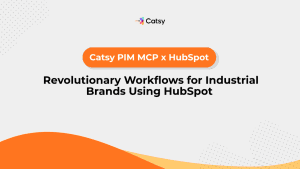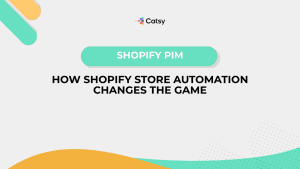Catsy PIM MCP: Revolutionary Workflows for Industrial Brands Using HubSpot
A Guide to Catsy PIM MCP for HubSpot and Industrial Brands
- Ceejay S Teku
- October 8, 2025
- 12:33 am

Table of Contents
What You'll Learn:
- How industrial manufacturers overcome content creation bottlenecks through intelligent workflow automation between Catsy PIM and HubSpot
- The technical architecture of Model Context Protocol integration that enables seamless product data access for content generation
- Practical implementation strategies for pulling rich product information from Catsy into Claude for sophisticated campaign development
- Advanced automation techniques that transform raw product data into personalized, brand-consistent marketing campaigns at scale
- Performance measurement frameworks and optimization strategies for continuously improving automated content workflows
Imagine that it’s 5 PM. Your marketing team is still scrambling to create product specifications for the technical documentation that’s set to launch tomorrow. They’re juggling spreadsheets, hunting through folders, and trying like mad to maintain brand consistency across dozens of SKUs. Sound familiar?
This scenario plays out daily in industrial manufacturing companies where product catalogs expand faster than marketing resources. Like a ship caught in choppy waters without proper navigational tools, your marketing teams drift from task to task, struggling to chart a clear course toward campaign completion.
I’ve spent years optimizing complex data workflows, and have watched countless manufacturers struggle with what I call a “document creation paradox.” The more successful your product line, the harder it is to create compelling content at speed and scale.
This breakthrough comes from recognizing that content creation isn’t a creative bottleneck, it’s a data orchestration challenge. When your product information, brand guidelines, and customer insights are siloed, even the most talented marketers will spend more time simply gathering the information they need to create compelling campaigns.
Integrating Catsy’s PIM with Claude through Model Context Protocol changes this dynamic, particularly with HubSpot’s marketing automation. Rather than fight data friction, your marketing teams can focus on what matters: strategic planning.
1. The Industrial Content Creation Bottleneck: Why Traditional Workflows Break Down
Let’s walk through what typically happens when an industrial manufacturer needs to launch a new product campaign.
The marketing team receives a brief about upcoming launches. Maybe it’s a new hydraulic component line or a specialized fastener collection. Regardless, what follows is a familiar dance of inefficiency.
The Traditional Workflow Reality
First, someone needs to gather product specs from various sources:
- The PIM system for technical details
- Design files from engineering teams
- Inventory levels from operations
- Pricing information from sales
Each system speaks a different language, stores data in different formats, and requires separate credentials for access.
Next, the content creation phase begins:
- Writers craft product descriptions while referencing accurate specification sheets
- Designers search for approved assets while trying to understand product positioning
- Email marketers build campaigns while making educated guesses about which products will resonate with specific customer segments
According to Content Marketing Institute research, 65 percent of business to business marketers struggle with creating content at scale, with product-focused manufacturers facing the greatest challenges. The problem isn’t talent or creativity. It’s the friction between data systems and creative processes.
Where Industrial Manufacturers Face Unique Challenges
Industrial manufacturers operate in a particularly complex environment. Unlike traditional distributors, these companies need to be simultaneously product-focused and solution-driven.
For instance, a precision bearing isn’t just about load capacity. It’s about reliability, application compatibility, and operational efficiency. Nuanced positioning like this requires that your content weave your tech specs together with performance benefits.
The challenge multiplies when you consider the pace of industrial operations:
- Seasonal maintenance cycles
- Equipment upgrade windows
- Regulatory compliance updates
- Supply chain-driven promotions
All of these create constant pressure for fresh, relevant content. HubSpot’s State of Marketing report reveals that 64 percent of marketers actively use AI for content creation. However, most implementations focus on generic copywriting rather than product-specific, brand-aligned content generation.
Traditional workflow tools treat product information as static. In reality, though, it’s your dynamic content fuel!
As a result, marketing teams spend 60-70 percent of their time on data gathering and formatting, leaving minimal resources for strategic thinking and creative optimization.
2. Understanding Catsy PIM MCP: The Technical Foundation
Okay, so here’s where things get interesting, at least from a technical perspective. The Model Context Protocol integration with Catsy PIM creates what I think of as an “intelligent data bridge.” This fundamentally changes how your product info moves into your creative workflows.
The Technical Architecture
MCP enables Claude to access Catsy’s product database directly, not as a static export, but as a living, contextual source of data. When a marketing team member asks Claude to create content for a specific product or collection, the system doesn’t just retrieve basic specifications. Instead, it understands relationships, hierarchies, and business context.
Here’s a different way to think of it: imagine that rather than handing someone a list of parts and asking them to describe a machine, you give them access to the engineer who designed it, the marketer who positioned it, and the sales data that shows how customers use it.
Key Technical Capabilities
- Real-Time Data Access: Product information, inventory levels, and pricing updates flow directly from Catsy without manual synchronization
- Contextual Understanding: Claude comprehends product relationships, seasonal relevance, and brand positioning guidelines stored in the PIM system
- Structured Query Interface: Marketing teams can request specific product subsets, attribute combinations, or cross-category relationships using natural language
The MCP Advantage for Industrial Manufacturers
What makes this particularly powerful for industrial brands is how MCP handles complex product relationships.
A precision machining company might have products connected by material specifications, manufacturing processes, tolerance requirements, and application categories. Traditional integrations require that marketers manually map these relationships for each campaign, costing valuable payroll hours.
With MCP, Claude inherently understands these connections. Ask for “machining components with +/- 0.001″ tolerance under $500 for automotive applications.” The system will return not just a product list, but contextual information about precision benefits, application-specific advantages, and price positioning within the broader catalog.
Implementation Simplicity
From an implementation standpoint, the beauty lies in its simplicity. Marketing teams don’t need API documentation or technical training. They interact with Claude using natural language while the MCP integration handles the complex data retrieval and processing in the background.
What this means for your business is democratic access to sophisticated intelligence. Your content creators, email marketers, and social media managers, for examples, can leverage your rich product data without a data science PhD.
3. Pulling Product Intelligence into Claude: Real-World Implementation
Let’s look at how this works in practice. Imagine you’re a marketing manager for an industrial fastener manufacturer, and you’re preparing for a seasonal campaign. Rather than opening multiple systems and compiling spreadsheets, you start a conversation with Claude.
Practical Query Examples
“Show me all stainless steel fasteners under $50 that meet ASTM standards, focusing on items that complement our bestselling bolt collection.”
Claude, through MCP, accesses your Catsy PIM system and returns not just product names and prices, but includes specification compliance, seasonal demand patterns, and cross-sell opportunities with your bolt line.
Advanced Product Intelligence Retrieval
The system goes well beyond basic product queries! You can ask Claude to:
- Identify products with similar application requirements but different price points
- Find maintenance items that historically perform well during specific industry cycles
- Locate products with regulatory certifications that align with current compliance trends
- Discover inventory items that need promotional support based on turnover rates
Content Creation with Context
Here’s where the magic happens. Once Claude has access to rich product data, content creation becomes contextually intelligent. For instance, you can request email copy for a spring maintenance campaign, and Claude generates content that:
- References specific product materials and performance specifications from your PIM system
- Incorporates seasonal positioning based on historical performance data
- Includes cross-sell recommendations derived from actual product relationships
- Maintains brand voice consistency using guidelines stored in your product database
Dynamic Campaign Development
According to Salesforce research, 67 percent of marketing leaders use automation platforms, but most struggle with personalization at scale. The Catsy-Claude-HubSpot integration solves this by making personalization a natural outcome of rich data access rather than a separate technical challenge.
Real-World Workflow Example
A precision bearing manufacturer launching a new heavy-duty collection might follow this workflow:
- Data Discovery: “Claude, show me all heavy-duty bearings in our industrial collection, including materials, load ratings, and customer feedback.”
- Content Generation: “Create email campaign content for our manufacturing-focused customer segment, emphasizing durability and performance specifications.”
- Campaign Optimization: “Suggest complementary products for cross-selling and identify the best sending times based on this segment’s engagement history.”
The entire process, from product discovery to campaign-ready content, takes just minutes rather than hours. Meanwhile, your content maintains contextual depth that makes industrial manufacturers successful.
4. Automated Content Campaign Creation: From Product Data to HubSpot Execution
The integration really shines when you consider how seamlessly content flows from Claude into HubSpot’s campaign execution engine. This isn’t just about generating copy—it’s about creating complete, executable marketing campaigns that understand both product context and customer behavior.
Intelligent Campaign Architecture
When Claude generates content using Catsy product data, it creates what I call “campaign ecosystems.” Instead of isolated pieces of copy, you get interconnected content that works across multiple touchpoints:
- Email sequences that reference specific product benefits and cross-sell opportunities
- Social media content that maintains consistent messaging while adapting to platform-specific formats
- Landing page copy that aligns with email campaign messaging and product positioning
- Retargeting ad content that builds on previous customer interactions
HubSpot Integration Benefits
The HubSpot PIM integration becomes the execution layer that transforms Claude-generated content into active marketing campaigns. Product-rich content automatically populates:
- Dynamic email templates with real-time inventory and pricing
- Workflow triggers based on product availability and seasonal relevance
- Customer segmentation rules informed by product preference patterns
- A/B testing scenarios that leverage product attribute variations
Advanced Automation Scenarios
Here’s where industrial manufacturers gain competitive advantages. Consider these automated workflow possibilities:
Inventory-Driven Campaigns: When certain products reach predetermined inventory levels, the system automatically generates clearance campaigns with appropriate messaging, discount structures, and urgency indicators.
Seasonal Transitions: As seasons change, Claude analyzes historical performance data and automatically creates transition campaigns that move customers from spring maintenance to summer production products, complete with application suggestions and complementary item recommendations.
Customer Lifecycle Automation: New customer welcome series automatically adjust based on initial product purchases, creating personalized onboarding experiences that feel curated rather than templated.
Performance Optimization Loops
Research from Dynamic Yield shows that brands using advanced personalization see conversion rate increases up to 19 percent. A Catsy-Claude-HubSpot integration creates continuous optimization loops where:
- Campaign performance data flows back to inform future content generation
- Product success patterns influence automated recommendation engines
- Customer engagement metrics refine segmentation and messaging strategies
- A/B testing results automatically update content generation parameters
Content Consistency at Scale
One challenge industrial manufacturers face is maintaining brand voice consistency as content volume increases. The integration solves this by storing brand guidelines, tone preferences, and messaging frameworks directly in the product data structure. Every piece of generated content inherently reflects your brand personality while adapting to specific product contexts.
5. Measuring Success: Performance Optimization and Continuous Improvement
The beauty of an integrated approach like this one lies not just in content creation efficiency, but in the continuous improvement cycles it enables. When product data, content generation, and campaign performance exist in a connected ecosystem, optimization becomes systematic rather than guesswork.
Key Performance Indicators for Automated Workflows
Traditional marketing metrics tell part of the story, but integrated workflows require more sophisticated measurement approaches:
- Content Generation Velocity: Time from product launch to campaign execution
- Cross-Product Engagement: How well automated recommendations drive multi-category purchases
- Brand Consistency Scores: Maintaining voice and positioning across automated content
- Inventory Alignment: How effectively campaigns match product availability and business priorities
Advanced Analytics Integration
The system creates rich feedback loops between campaign performance and content optimization. Digital asset management capabilities ensure that high-performing content assets and messaging frameworks are systematically captured and reused across future campaigns.
Continuous Learning Architecture
Claude learns from campaign performance data, gradually improving content generation based on what actually drives results for your specific brand and customer base. This creates compound benefits where automated content becomes increasingly effective over time.
Optimization Strategies
- A/B Testing at Scale: Automatically test different product positioning approaches across customer segments
- Seasonal Performance Learning: Build institutional knowledge about what messaging works best for specific products during different times of year
- Customer Journey Refinement: Identify optimal content sequences that move customers from awareness to purchase across your product categories
ROI Measurement Framework
The integrated approach enables sophisticated ROI analysis that considers both efficiency gains and performance improvements:
- Time Savings: Quantify hours saved in content creation and campaign setup
- Revenue Attribution: Track how automated campaigns contribute to overall business growth
- Customer Lifetime Value: Measure how personalized, product-intelligent campaigns affect long-term customer relationships
- Operational Efficiency: Calculate the business impact of reduced manual workflow friction
Future-Proofing Your Marketing Operations
As your product catalog grows and customer base expands, the integrated system scales naturally. New products will automatically inherit appropriate content templates and campaign frameworks, and customer segmentation will become increasingly sophisticated based on growing sets of behavioral data.
Key Takeaways
- Data orchestration transforms creative efficiency: The biggest content creation bottleneck isn’t creativity. It’s the friction between product data systems and marketing workflows, which MCP integration elegantly solves.
- Contextual intelligence enables authentic personalization: When Claude has direct access to rich product relationships and brand guidelines through Catsy PIM, content generation maintains authenticity while achieving scale.
- Automated workflows amplify human strategic thinking: Rather than replacing creativity, intelligent automation handles data gathering and initial content generation, freeing marketers to focus on strategy and optimization.
- Continuous improvement becomes systematic: Integrated performance data creates learning loops that make automated content increasingly effective over time, building competitive advantages through institutional knowledge.
- Scalability without complexity: As industrial manufacturers grow, the integrated system naturally accommodates larger product catalogs and more sophisticated customer segmentation without requiring proportional increases in manual effort.
- With Catsy PIM MCP as your compass and HubSpot as your trusted vessel, your marketing team can navigate even the most complex product catalogs with confidence. Keep your content creation efforts steadily on course toward measurable business growth.
FAQs:
How does Claude maintain brand voice consistency when generating content from product data?
Brand guidelines, tone preferences, and messaging frameworks are stored directly in the Catsy PIM system. Claude accesses these parameters for each request for content generation, ensuring that brand consistency is built into the automation … not just an afterthought.
Can the system handle complex product relationships like component assemblies or specification hierarchies?
Absolutely! MCP enables Claude to understand hierarchical product relationships, assembly configurations, and even specification dependencies that’s stored within the PIM. Content generation will automatically incorporate these relationships for cross selling and for product recommendations.
How quickly can marketing teams see ROI from implementing this integrated approach?
Most industrial manufacturers report immediate gains in efficiency through reduced content creation time, typically seeing a 60 to 70 percent reduction in campaign setup time… all within the first month. Revenue impact usually becomes measurable within around 60 to 90 days as your personalized campaigns begin to outperform generic approaches.
What happens if product information changes frequently, like pricing or inventory levels?
The MCP integration provides real-time data access, so content generation always uses current product information. Automated workflows can also trigger campaign adjustments when significant changes occur, ensuring marketing messages remain accurate and relevant.
How does the system handle seasonal transitions and industry cycle-based marketing?
Claude can analyze historical performance patterns and seasonal indicators that are stored in the Catsy PIM to automatically adjust both messaging and product positioning. The system learns which products perform best during which time, and will adapt content generation accordingly.
Ceejay S Teku
Consider multi-store architecture when you are facing significant regional product variations. Complex compliance requirements and distinct customer segments should also be considered.
Typically, manufacturing businesses will benefit from multi-store approaches. This is especially true if you’re serving markets with different safety standards or regulatory requirements. Remember, too, that business-to-business and business-to-consumer customers will have fundamentally different purchasing processes.
Effective inventory management requires integration between your stores and your legacy systems. This usually involves middleware solutions.
You can synchronize your stock levels, coordinate fulfillment, and manage your regional allocation strategies. The key lies in maintaining real-time visibility across each of your channels while enabling flexible fulfillment.
The primary challenges you may face include management of safety standards, tech documentation, and environmental regulations. Proper customs and import documentation may also come into pay.
Each market may require different certifications, testing procedures, and ongoing compliance monitoring, and these must be integrated into your multi-store operations.
The primary challenges you may face include management of safety standards, tech documentation, and environmental regulations. Proper customs and import documentation may also come into pay.
Each market may require different certifications, testing procedures, and ongoing compliance monitoring, and these must be integrated into your multi-store operations.





